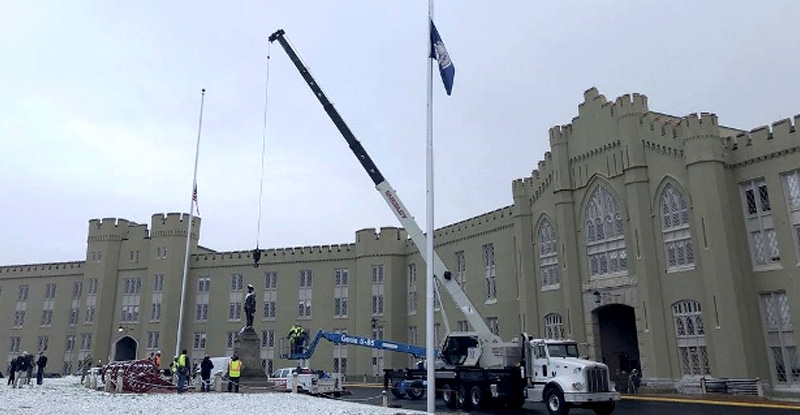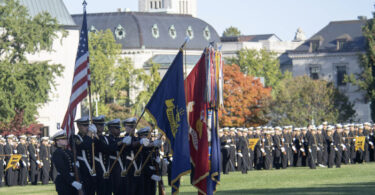By Forrest L. Marion, PhD, VMI Class of 1980
Retired U.S. Air Force officer and military historian
David Bernstein, the author of Woke Antisemitism: How a Progressive Ideology Harms Jews, remarked:
“When you have an ideology that pretends to know exactly who the oppressors are and who are the oppressed, and you have an ideology that conflates success with oppression . . . then Jews who do, on average, better than the mean, are going to be viewed as oppressors.”
This is commonsensical given Critical Race [racist] Theory’s ascendancy especially in the last several years, which is based on an oppressor-oppressed paradigm.
Among the many problems raised by CRT is its abandonment of traditional Western meritocracy in lieu of its gods, Diversity-Equity-Inclusion (DEI).
Bernstein rightly views CRT’s ditching of meritocracy as leading to conflating success with oppression.
Data supports Bernstein’s argument – without apologies to those CRT ideologues who view the use of data, facts, and logic as prima facie evidence of white supremacist culture (note: Equitable Math promotes this lunacy).
In 2021, the Pew Research Center found that “More than nine-in-ten U.S. Jews surveyed say there is at least some anti-Semitism in America, and three-quarters say there is more anti-Semitism in the U.S. today than there was five years ago.”
This increased anti-Semitism is no surprise to those even dimly aware of what CRT teaches, who also are cognizant of CRT’s capture of major segments of American society including government, business-media-entertainment, and institutions once known for higher education rather than divisive, alternate-reality-based propaganda.
Two years ago, mathematician and cultural commentator James Lindsay addressed a watershed article by Bari Weiss, a former New York Times writer, whose piece in Tablet magazine called upon readers to “Stop Being Shocked” at the latest trend of anti-Semitism nurtured, arguably, by the “new ideology vying to replace” American liberalism.
At the time, a veritable witch’s brew of terms including postcolonialism, identity politics, and neo-Marxism were employed to describe the new ideology.
Lindsay, who argued for the term Critical Social Justice – closely related to CRT – led off his article with, “[CRT] has a Jewish problem, and, finally, people are beginning to notice.”
Critical Social Justice must be understood, he continued, “. . . including the extremely unpleasant, if not genuinely horrifyingly anti-Semitic [rationale] this new ideology generates for the Jews.”
In short, whereas CRT purports to advocate for the oppressed (mainly those of color) who suffer at the hands of the oppressors (mainly whites) – its ideologues will kindly identify for the rest of us exactly who qualifies for each group – in the real world their juvenile paradigm is intellectually and morally bankrupt.
In one plain example, CRT views the Jews – easily among the most historically oppressed people groups in world history – as belonging to the oppressor class. Who knew?
Enter the Virginia Military Institute (VMI) in the fall of 2020, in the aftermath of then-disgraced-Governor Ralph Northam’s letter to the board of visitors (BoV) accusing the school of unsubstantiated institutional or “structural racism.”
In February 2022, VMI’s superintendent acknowledged those charges “are not supported by the facts.”
But in the heat of the moment in 2020, the Institute’s BoV decided to remove the statue of Lt. Gen. “Stonewall” Jackson from its honored position in front of the cadet barracks.
Most likely, it never crossed their minds that the decision might suggest a degree of institutional anti-Semitism.

Around 9:45 a.m. on December 7th 2020, a crane plucked the larger-than-life statue (that freshmen were once required to salute) off its base and slowly hoisted it to the ground. A small crowd gathered quietly on the mostly empty campus in Lexington where Jackson once taught, quietly looking on amid flurries of snow.
How so? The sculptor of Jackson’s VMI statue, Moses Jacob Ezekiel, was born in Richmond, Virginia, in 1844, one of 14 children residing “in a poverty-stricken neighborhood,” according to the Jewish-American History Foundation.
In the second year of the war between North and South, in September 1862 Ezekiel was admitted as a cadet at VMI.
His mother realized her son might end up fighting for the South. “She admonished him, as she sent him off to VMI to learn the arts of war, that she wouldn’t have a son who would not fight for his home and country.” His country, of course, was Virginia.

Moses Jacob Ezekiel, VMI 1866
Ezekiel was VMI’s first Jewish cadet, which presented some challenges. In 1863, the superintendent, Maj. Gen. Francis Smith, had to secure permission from the BoV “for Moses to be furloughed to join his family for the ‘Feast of Unleavened Bread.’”
On May 15, 1864, Ezekiel was among the VMI cadets who fought and helped defeat a Union force at New Market, north of Lexington. As his mother might have wished, Ezekiel, a private in Company C, participated in a direct assault on the Union lines.
After the battle, he assisted in the traumatic task of recovering the dead and wounded from the field. One of them was Cadet Thomas Garland Jefferson, “desperately wounded in the chest.”
Ezekiel, one of many cadets who had lost their shoes in the mud, walked barefoot into town to obtain a wagon. Jefferson was taken to a nearby home where he suffered terribly while Moses “nursed him and read to him from the Bible.”
On the night of May 17th, Jefferson’s Jewish friend read to him from the New Testament by candlelight: “In my Father’s house are many mansions: if it were not so, I would have told you. I go to prepare a place for you.”
Jefferson died in Ezekiel’s arms that night. Moses Ezekiel carried the emotional impact of the battle’s aftermath and the loss of his fellow cadets with him for life.
Ezekiel graduated from VMI in 1866. He had already begun to show talent as an artist. He studied anatomy at the Medical College of Virginia, then attended art school in Cincinnati. In 1869 Ezekiel traveled to Berlin and studied at the Royal Art Academy.
At age 29, he became the first non-German to win a major art competition for a bas relief entitled “Israel.” With the prize money, Ezekiel moved to Rome where he resided for the rest of his days.
Ezekiel was prolific as a sculptor, completing nearly two hundred sculptures in bronze and marble. Among his greatest was a marble group, entitled, “Religious Liberty” (or, “Religious Freedom”), created for the 1876 centennial exposition in Philadelphia.
A number of Ezekiel’s works reflected his ties to Virginia and the South, including “Virginia Mourning Her Dead,” which memorialized the ten cadets who perished at New Market. It was dedicated at VMI in 1903.
His original statue of Stonewall Jackson was created for Charleston, West Virginia. In 1912 – five years before Ezekiel’s death – a replica of that statue was emplaced in front of the VMI barracks’ Jackson Arch, replacing “Virginia Mourning Her Dead,” which was relocated nearby in front of the engineering building.
Stonewall’s statue remained there until December 2020 when VMI removed it in reaction to incessant false and ignorant accusations hurled at the school and at Jackson’s memorialization.
Granted, VMI’s decision to remove Ezekiel’s Jackson statue likely was made without any thought given to the fact that it “canceled” some portion of the international reputation of the school’s first Jewish alumnus.
How ironic that such a decision was made in a vain attempt to satisfy those claiming advocacy for “the oppressed.”
Further, the decision was institutional, not individual.
In contrast to accusations of structural or institutional racism at VMI intended to remove a supposed white supremacy culture there, the statue’s removal constitutes, arguably, an authentic example of institutional partiality.
If, thankfully, not the worst example of anti-Semitism, yet it is greater than zero – whereas the claims of institutional, structural, or systemic racism at VMI are, in fact – zero.
Sadly, VMI is not alone in this kind of behavior.
Princeton University canceled an exhibit of 19th-century Jewish art that included works by Ezekiel and painter Theodore Moise because of their ties to the Confederacy. The show’s curator, Samantha Baskind, correctly viewed the decision as “an unfortunate anti-intellectual surrender to cancel culture,” adding that removing the artists with Confederate ties “rewrites art history.”
Just imagine the outcry of racism, oppression, or anti-intellectualism if a major work created by a black sculptor or artist was removed from a college campus nowadays? The school’s president would be gone within days.
But in today’s culture, controlled by the twisted ideology of CRT/DEI, a famous statue created by VMI’s first Jewish graduate, who rose from humble origins and endured many trials in route to international acclaim – while maintaining deep affection for the Institute – passes without a whisper of institutional anti-Semitism.
In any case, VMI graduate and New Market veteran Moses Ezekiel lived by the word inscribed on the earliest VMI class ring: “Mizpah,” from the Torah (the Pentateuch), meaning, “May the LORD watch between you and me when we are absent one from the other.”
Having read this far, if you remember nothing else, remember Mizpah. . . .
Forrest L. Marion, PhD
VMI Class of 1980
First published in The Roanoke Star in December 2022
Arlington National Cemetery Wants to Know What You Think About Removing Its Confederate Memorial








Leave a Comment